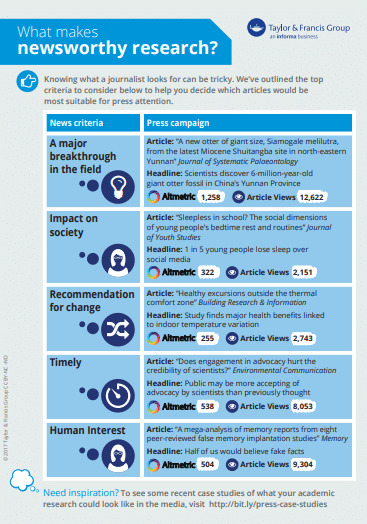Working with the media to promote your research
Engaging with the media is one of the best ways to raise awareness about your research to the public and policymakers.
The routes you use to communicate your research will vary depending on your subject matter and the audience you wish to reach.
Read on to learn about the benefits of promoting your work in this way, what types of research journalists might be looking to cover, and our tips for making the most of media opportunities.
Reaching out to the media is something we are proud to support you with when publishing with us. Using our extensive expertise with working alongside colleagues in the press, we follow Stempra guidelines to make sure that research is managed responsibly, and then targeted to credible journalists working on some of the largest publications across the world.

It’s a great way of maximizing impact, but what are the specific benefits of publicizing research through the media?
Increase the impact of research
In order to increase citations and research impact, your article needs to be seen by the right people. Not only can the press bring research to the general, non-specialist public, it can also be a useful tool for getting your ideas heard by other researchers. Press activities can be focused on specialist and subject-specific publications, which are targeted primarily at those working within the right industry.Giving back to society
In an age of homespun journalism and ‘fake news’ where everyone can share their story on social media, the need for evidence and an expert voice is more important than ever before. In the case of publicly funded research, media coverage provides a key channel to inform taxpayers of the results of research they indirectly support.Change in practice
Much research, particularly in the medical profession, ultimately aims to inform policy and practice. A lack of knowledge of the latest guidance can act as a major barrier to change in practice. The media’s wide-reaching nature, but also its potential for specialized targeting, makes it a powerful tool to combat this barrier.Promotes the field of research
A strong correlation has been reported between media consumption and confidence in science and scientists. The positive perception of scientific research, in turn, could have a knock-on effect in terms of attracting people into the industry.It may support researchers’ bids for future funding
Funders could be influenced by the “media profile” of the researcher when considering an application. The ripple effect that media coverage can have on generating support for future funding is often cited as a key motivator for science communications.It is an external acknowledgement of individual and institutional achievements
Universities are as keen for the research emerging from their institution to make an impact as their researchers are, and have their own challenging targets to reach in these areas. Therefore, any boost to their brand or reputation is highly appreciated and could help you to strengthen working relationships in the process.Increase your article’s Altmetric score
Mentions on news articles contribute to your article’s Altmetric Attention Score. This is a good way of measuring and tracking the impact of your work, including who is saying what about your work. Find out more about the Altmetric Attention Score.
Using a press campaign to get your article into the media can help your research achieve greater impact.
An article with newsworthy potential will:
Involve major discoveries
Have an impact on society
Feature recommendations for change in practice
Tie to a timely topic or event

Research in the news: real world examples
Click the infographics to expand and view them. They show the impact statistics for some of our recent press campaigns.
You can see how a similar pattern is followed in our most successful press campaigns in 2021. Each of these press releases, worked on with our Newsroom, helped the article receive worldwide attention – something which was reflected as they each achieved Altmetric Attention Scores of over 1,000:

Not all research articles may grab the attention of a busy and increasingly pressured journalist.
When you are considering whether your research should be pitched to the media, first ask yourself ‘what would the headline in a national newspaper be?’. Would it capture the interest of a journalist, who not only knows little about your research before opening their emails, but also needs to grasp their readers’ interest within a matter of a few words?
The main instances when an article might not be suitable for a press campaign include:
It has already published. If an article has already published, it vastly reduces its chances of making the cut
It’s interesting but doesn’t offer anything new for journalists to cover, for example a literature review
It’s very niche – if it focuses on a very specific region, group of people or subject area
The sample size of the study is small, or the discipline is not yet mature enough
You are unable to answer journalist queries. Being available to provide additional comments about your research is important to journalists who will want to have their own take on the story

10 top tips for working with journalists from Fran Abrams, Chief Executive of the Education Media Centre
Take advice
You’re not alone. If you’re in a university, its press office can help with support, contacts, and media training. There are also organizations (like the Education Media Centre) which help connect academics to good, specialist journalists.Be strategic
Before you start, think about why you want to publicize your work, and what you want to achieve. Consider timing – approach journalists at a time when you think they’re likely to be interested – that is, when it’s topical.Don’t expect journalists necessarily to share your agenda
Just because you think something’s academically significant, it doesn’t mean it’ll be a big story – journalists want to be surprised. Remember the maxim that ‘dog bites man’ isn’t news, but ‘man bites dog’ could be.Do your research
Listen to the radio, read the papers and websites where you’d like to see your work featured. Then make your pitch relevant to their interests.Try to give journalists some notice
A week is ideal for a daily news outlet; but if you’re approaching someone for a longer, more in-depth feature, more time is needed.Have a clear message; deliver it in plain English
If you’re writing a press release or emailing a journalist, use the kind of language you might use when describing your work to a friend – don’t use slang, but don’t use jargon either.Remember journalists are up against it
If you’re approached for a comment, you’ll need to respond within a few hours if it’s for a daily news outlet. And if you’re approaching them, remember they have hundreds of emails every day and very little time. So be short and to the point.Consider how much time you can devote
Even when you’ve been interviewed, there’s no guarantee anything will appear. It can be frustrating, but it’s very worthwhile when it works.Think about your comfort zone
If you’re nervous, take small steps. A blog post or some activity on Twitter can be a good place to start. If you’re worried about how an aspect of your work might be represented, say so.Remember journalists are human
Most of them want to get it right. If you feel you haven’t been treated fairly, take it up politely with the individual journalist first before moving up the chain of command if you really need redress. And don’t forget to say ‘thank you’ if you liked the report.
If you are unsure
Contact the Taylor & Francis Newsroom, who will offer support on the best way to communicate your research.
At Taylor & Francis, we aim to work closely with our authors and journal editors to ensure that cutting-edge research achieves the maximum possible impact in the media.
If you are the author of an article that is being published in a Taylor & Francis or Routledge journal, and you think that your research fulfils the criteria above, you can nominate it using our Press Nomination Form. The best time to do this is as soon as your article is accepted by a journal after peer review, before it publishes online.
Taylor & Francis press releases are distributed through multiple channels including the Taylor & Francis Newsroom, via third-party distributors, and social media.
Each release is expertly dealt with. The team are all members of Stempra and follow their media officer guidelines to ensure our releases are not only sent out to achieve maximum impact, but communicated responsibly.

In line with this we also follow The Academy of Medical Science’s recommendations to help raise trust in science press releases, by providing a clear label showing whether research findings have been through peer-review, and a summary of the type of research.
This is in addition to a wide range of supporting marketing activities carried out by our team of experts.
For any more information on press campaigns, please get in touch at [email protected]
Expert help for your research promotion
Taylor & Francis Research Communication Services will help you reach and engage with peers, new audiences and impress your funders and the media with you work.





